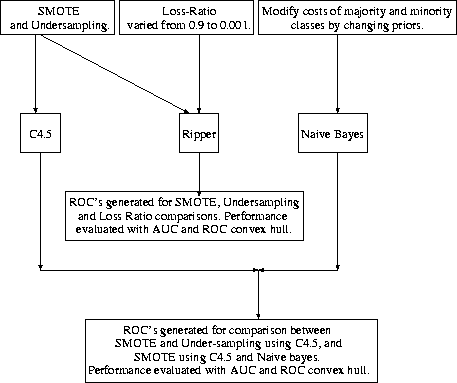


Next: Datasets
Up: SMOTE: Synthetic Minority Over-sampling
Previous: Under-sampling and SMOTE Combination
We used three different machine learning algorithms for our experiments. Figure 6 provides
an overview of our experiments.
Figure 6:
Experiments Overview
 |
- 1.
- C4.5: We compared various combinations of SMOTE and under-sampling with plain under-sampling
using C4.5 release 8 [21] as the base classifier.
- 2.
- Ripper: We compared various combinations of SMOTE and under-sampling with plain under-sampling
using Ripper [22] as the base classifier. We also varied Ripper's loss ratio [31,4]
from 0.9 to 0.001 (as a means of varying misclassification cost) and compared the effect of this
variation with the combination of SMOTE and under-sampling. By reducing the loss ratio from 0.9 to
0.001 we were able to build a set of rules for the minority class.
- 3.
- Naive Bayes Classifier: The Naive Bayes Classifier
![[*]](foot_motif.gif) can be made cost-sensitive by
varying the priors of the minority class. We varied the priors of the minority class from 1 to 50 times
the majority class and compared with C4.5's SMOTE and under-sampling combination.
can be made cost-sensitive by
varying the priors of the minority class. We varied the priors of the minority class from 1 to 50 times
the majority class and compared with C4.5's SMOTE and under-sampling combination.
These different learning algorithms allowed SMOTE to be
compared to some methods that can handle misclassification costs directly. %FP and %TP were
averaged over 10-fold cross-validation runs for each of the data combinations. The minority class
examples were over-sampled by calculating the five nearest neighbors and generating synthetic
examples. The AUC was calculated using the trapezoidal rule. We extrapolated an extra point of TP =
100% and FP = 100% for each ROC curve. We also computed the ROC convex hull to identify the
optimal classifiers, as the points lying on the hull are potentially optimal classifiers
[1].



Next: Datasets
Up: SMOTE: Synthetic Minority Over-sampling
Previous: Under-sampling and SMOTE Combination
Nitesh Chawla (CS)
6/2/2002

![[*]](foot_motif.gif) can be made cost-sensitive by
varying the priors of the minority class. We varied the priors of the minority class from 1 to 50 times
the majority class and compared with C4.5's SMOTE and under-sampling combination.
can be made cost-sensitive by
varying the priors of the minority class. We varied the priors of the minority class from 1 to 50 times
the majority class and compared with C4.5's SMOTE and under-sampling combination.